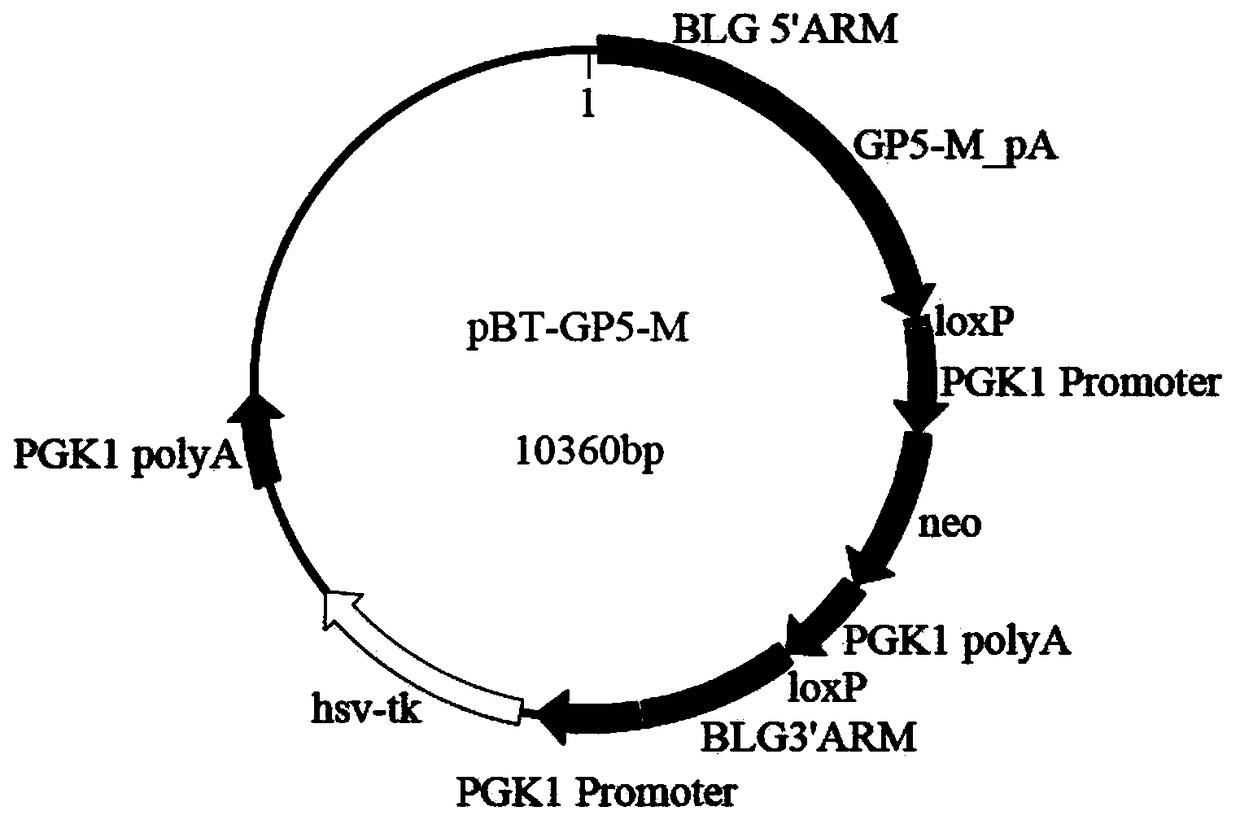Preparation method of milk goat mammary gland bioreactor for expressing GP5-M protein in milk
A bioreactor, GP5-M technology, applied in the field of goat mammary gland bioreactor preparation, can solve the problems of microbial processing, high price of active substances, inability to synthesize active protein, etc., to achieve large output, low cost, and maintain biological active effect
- Summary
- Abstract
- Description
- Claims
- Application Information
AI Technical Summary
Problems solved by technology
Method used
Image
Examples
Embodiment 1
[0079] Construction of gene targeting vector
[0080] (1) Cloning of GP5-M gene
[0081] With reference to the GP5 and M protein gene sequences of the American representative strain of porcine reproductive and respiratory syndrome virus (PRRSV) VR2332 in GenBank, 2 pairs of primers SEQ ID NO:1-SEQ ID NO:4 were designed and synthesized. The primer sequences are as follows:
[0082] GP5 gene amplification primers:
[0083] Forward: TGTATCGTGCCGTTCTATCTTG; SEQ ID NO: 1
[0084] Reverse: GCAGTTCTTCGCAAGCCTAAT; SEQ ID NO: 2
[0085] M gene amplification primers:
[0086] Forward: TCGGGTACATGACATTCGTGC; SEQ ID NO:3
[0087] Reverse: TGCCGCAATCGGATGAAA; SEQ ID NO: 4
[0088] Extract viral genomic RNA, use random primers to reverse transcribe cDNA, use the cDNA as a template, use the above primers, and use the RT-PCR method, that is, the reaction conditions: 98°C for 3min; 98°C for 10sec, 54°C for 30sec, 72°C for 50sec (30Cycles) ; 72°C for 10 minutes; 4°C forever.
[0089] React...
Embodiment 2
[0096] Goat Fetal Fibroblasts Transfected with Targeting Vector pBT-GP5-M
[0097] Goat fetal fibroblasts are isolated from fetal tissues at 40 days of pregnancy, that is, the goat fetuses are collected by cesarean section, the limbs, head and internal organs are removed, the tissue pieces are cut into pieces and cultured, and the cells are frozen after confluence. Thaw primary goat fetal fibroblasts from liquid nitrogen at 38°C, centrifuge, discard the supernatant, add cell culture medium DMEM / F12+10% FBS to resuspend, take the cell suspension and inoculate it in a 6-well plate, place in 38°C in an incubator, 5% CO 2 cultivated under conditions. When the 1-3 generations of goat fetal fibroblasts reach 80% confluence, discard the culture medium and use Ca-free 2+ , Mg 2+ Rinse the cells with PBS, add trypsin digestion solution, and digest the cells. Observe the cells under an inverted microscope. When most of the cells retract, become round, and the intercellular space exp...
Embodiment 3
[0099] PCR identification of target cells
[0100] Design identification primers such as image 3 As shown, use PCR to amplify the sequence at the junction of the targeting vector and the genome, confirm that the targeting vector is correctly integrated into the targeting site, the amplified sequence spans the homology arm, and the 5'junction identification upstream primer is designed outside the 5' homology arm On the genome, the downstream primer is located on the target gene GP5; the 3'junction identification upstream primer is designed on the neo gene, and the downstream primer is located on the genome outside the 3' homology arm;
[0101] The sequences of the above identification primers are as follows:
[0102] 5'junction identification primers (PCR product 1226bp):
[0103] Forward: TAGCAACGCCCAAGTGGATTC; SEQ ID NO:5
[0104] Reverse: AAGCAACTGGCTGGTGGTGAG; SEQ ID NO: 6
[0105] 3'junction identification primer (PCR product 2388bp)
[0106] Forward: CCACCAAGCGAAACA...
PUM
 Login to View More
Login to View More Abstract
Description
Claims
Application Information
 Login to View More
Login to View More - R&D
- Intellectual Property
- Life Sciences
- Materials
- Tech Scout
- Unparalleled Data Quality
- Higher Quality Content
- 60% Fewer Hallucinations
Browse by: Latest US Patents, China's latest patents, Technical Efficacy Thesaurus, Application Domain, Technology Topic, Popular Technical Reports.
© 2025 PatSnap. All rights reserved.Legal|Privacy policy|Modern Slavery Act Transparency Statement|Sitemap|About US| Contact US: help@patsnap.com



